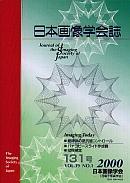Volume 61, Issue 3
Displaying 1-12 of 12 articles from this issue
- |<
- <
- 1
- >
- >|
Regular Paper
-
2022 Volume 61 Issue 3 Pages 194-199
Published: June 10, 2022
Released on J-STAGE: June 15, 2022
Download PDF (1478K) -
2022 Volume 61 Issue 3 Pages 200-208
Published: June 10, 2022
Released on J-STAGE: June 15, 2022
Download PDF (2090K)
Imaging Today
-
2022 Volume 61 Issue 3 Pages 210-218
Published: June 10, 2022
Released on J-STAGE: June 15, 2022
Download PDF (2379K) -
2022 Volume 61 Issue 3 Pages 219-224
Published: June 10, 2022
Released on J-STAGE: June 15, 2022
Download PDF (1075K) -
2022 Volume 61 Issue 3 Pages 225-235
Published: June 10, 2022
Released on J-STAGE: June 15, 2022
Download PDF (836K) -
2022 Volume 61 Issue 3 Pages 236-242
Published: June 10, 2022
Released on J-STAGE: June 15, 2022
Download PDF (1432K) -
2022 Volume 61 Issue 3 Pages 243-250
Published: June 10, 2022
Released on J-STAGE: June 15, 2022
Download PDF (2207K) -
2022 Volume 61 Issue 3 Pages 251-260
Published: June 10, 2022
Released on J-STAGE: June 15, 2022
Download PDF (1845K) -
2022 Volume 61 Issue 3 Pages 261-270
Published: June 10, 2022
Released on J-STAGE: June 15, 2022
Download PDF (977K) -
2022 Volume 61 Issue 3 Pages 271-279
Published: June 10, 2022
Released on J-STAGE: June 15, 2022
Download PDF (2141K)
Imaging Highlight
-
2022 Volume 61 Issue 3 Pages 280-285
Published: June 10, 2022
Released on J-STAGE: June 15, 2022
Download PDF (1442K)
Lectures in Science
-
2022 Volume 61 Issue 3 Pages 286-294
Published: June 10, 2022
Released on J-STAGE: June 15, 2022
Download PDF (1550K)
- |<
- <
- 1
- >
- >|
